A complete guide to making Easy Sautéed Vegetables for a tasty, nourishing side dish to any meal! This is my daily dose of veggies that I make 9 days out of 10. Whip up a big batch and eat it throughout the day or week!
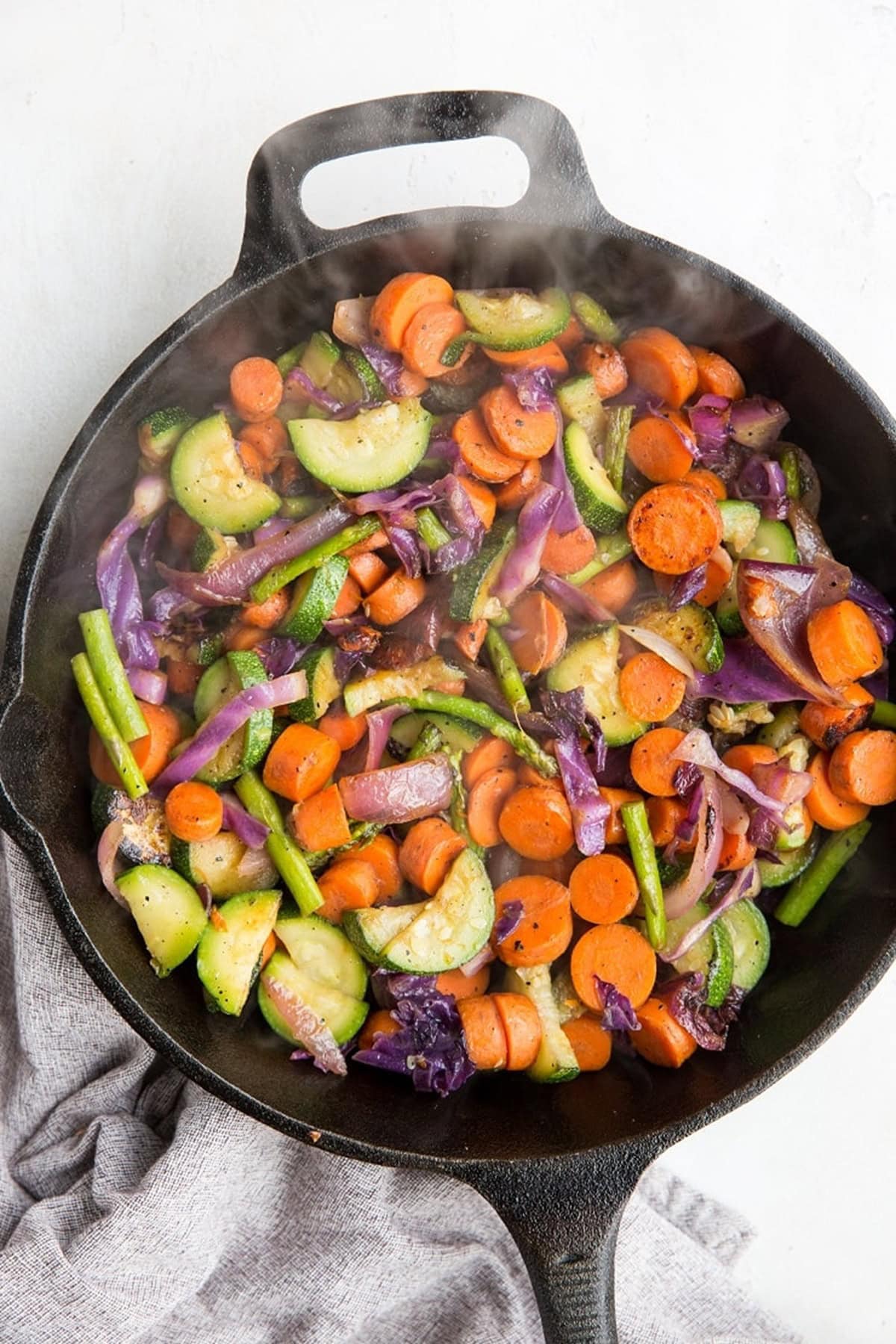
Searching for a quick, healthy, and colorful side dish for your next midweek meal? These easy sautéed vegetables are a nutritious and delicious way to hit your five a day. All you need is a little oil and a pinch of salt to let your stunning produce shine!
Sauteed vegetables is one of those side dishes you can put on repeat over and over and no one gets tired of it.
In fact, when friends come over for dinner, they’re always obsessed with these sautéed veggies.
People think I put some sort of secret magic into making vegetables taste good, but really the only trick is in the technique.
Vegetables will taste great as long as they’re cooked properly! Even vegetable naysayers and picky eaters will eat them, I do solemnly swear.
Not only does variety in plants and animals promote a diverse, beneficial gut microbiome, but it ensures you’re getting the micronutrients you need to stay energized with great focused and balanced hormones.
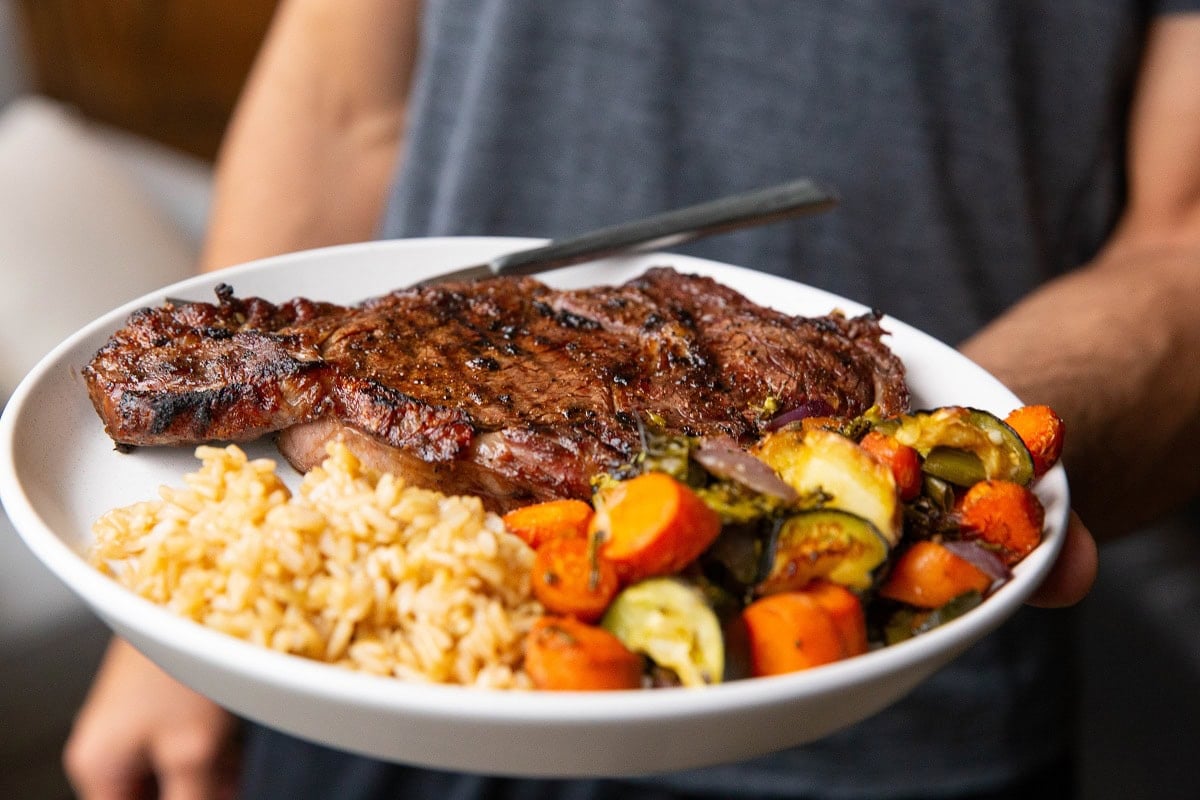
Enjoy this healthy side dish with a reverse-seared steak or perfect grilled chicken breast.
Best Vegetables to Use For Sauteed Vegetables:
When it comes to selecting vegetables for sautéing, I don’t tend to discriminate.
In my experience, most vegetables (including leafy greens) are wonderful when sautéed and most vegetables pair nicely together.
The key is to pair vegetables that are similar in heartiness to one another. For instance, onion, potatoes, and carrots are amazing together, and zucchini, asparagus and cabbage are a lovely combo.
In addition, I’ve found very soft vegetables like tomato and eggplant pair well with each other, but turn into mush when paired with heartier vegetables.
Take my Ratatouille Sauté as an example. Great when all of the vegetables are softer, not so great when pairing hard with soft.
The one exception I’ve found to this concept is zucchini and yellow squash. They tend to be right in the middle heartiness-wise, which makes them a candidate to pair with the tougher vegetables and the softer vegetables.
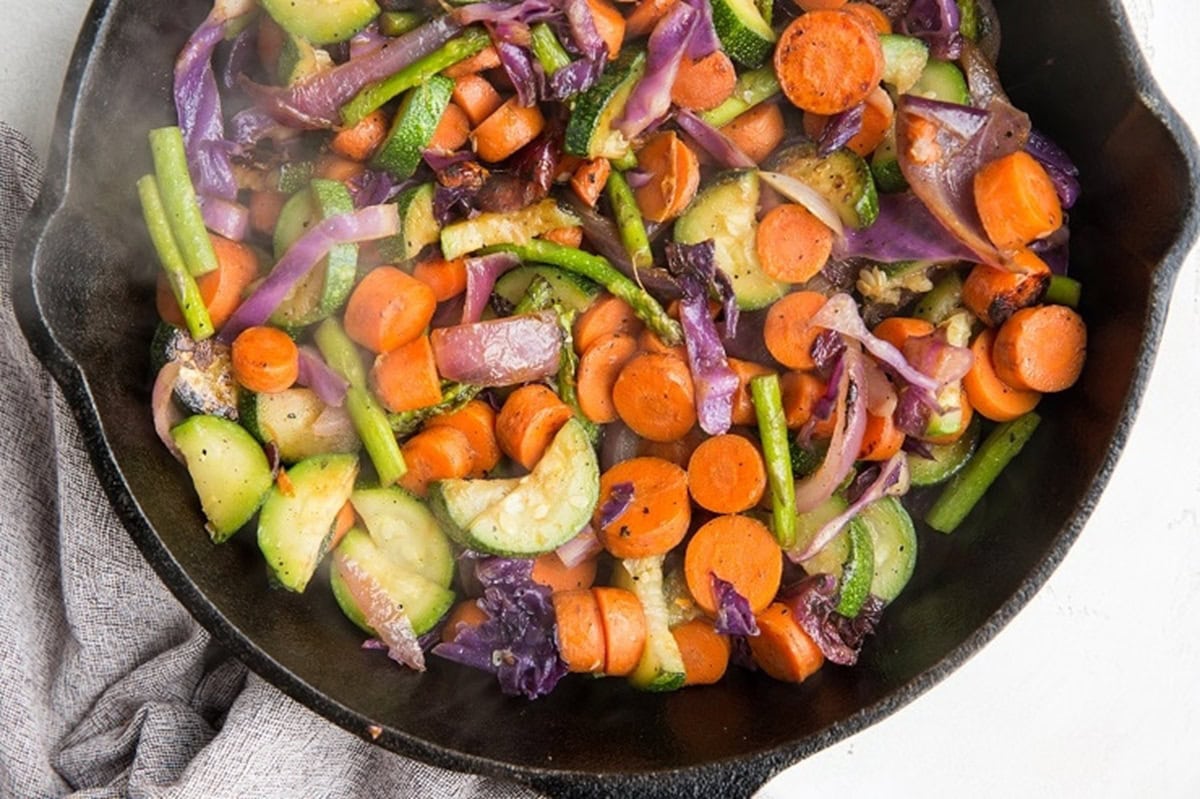
Now, let’s do this thing!
Ingredients for My Easy Sautéed Vegetables
The list below is my favorite combination of veggies for sautéing. There’s no wrong answer here, though! Use whatever’s seasonal and local to you. Otherwise, you can just use up leftover vegetables at the end of the week.
Avocado Oil: Avocado oil has a neutral flavor and a high smoke point, meaning it’ll crisp the vegetables nicely without burning. It is my preference over vegetable oil. I don’t recommend using olive oil when cooking in a hot skillet.
Red Onion: Hearty and sweet, red onion is the first vegetable to hit the pan!
Carrots: I pick the biggest carrots I can to create large, meaty chunks that’ll hold up well under the heat of the pan.
Zucchini Squash: Texture-wise, zucchini toes the line between tough and soft when sautéed. So, it’s great for texture!
Broccolini: The tips of your broccolini stalks will lightly char as they cook, adding a smoky depth to this tender, juicy superfood.
Asparagus: Woody and earthy, this veggie has a totally unique flavor. It remains tender and crisp under high heat, earning it a firm place among my favorite sautéed vegetables.
Red Cabbage: Loaded with antioxidants and vitamins, chopped red cabbage adds sweetness and a delightful pop of color to our veggies!
Sea Salt and Black Pepper: A small dash gives these vegetables all the flavor they need.
Recipe Customizations:
- Add a couple of tablespoons of liquid aminos, a splash of soy sauce, or coconut aminos at the end of the cook for a hit of glorious umami flavor!
- Try oregano, parsley, or a little garlic powder if you want a bit of extra seasoning (without overpowering the vegetables completely).
- Try adding some leafy greens like spinach or rainbow chard at the very end for a different texture! Red bell pepper, yellow onion, brussels sprouts, fresh green beans, cauliflower, green onions, and sweet potatoes are all marvelous options.
- Add red pepper flakes for some heat. Italian seasoning is great if you love the flavor of fresh herbs.
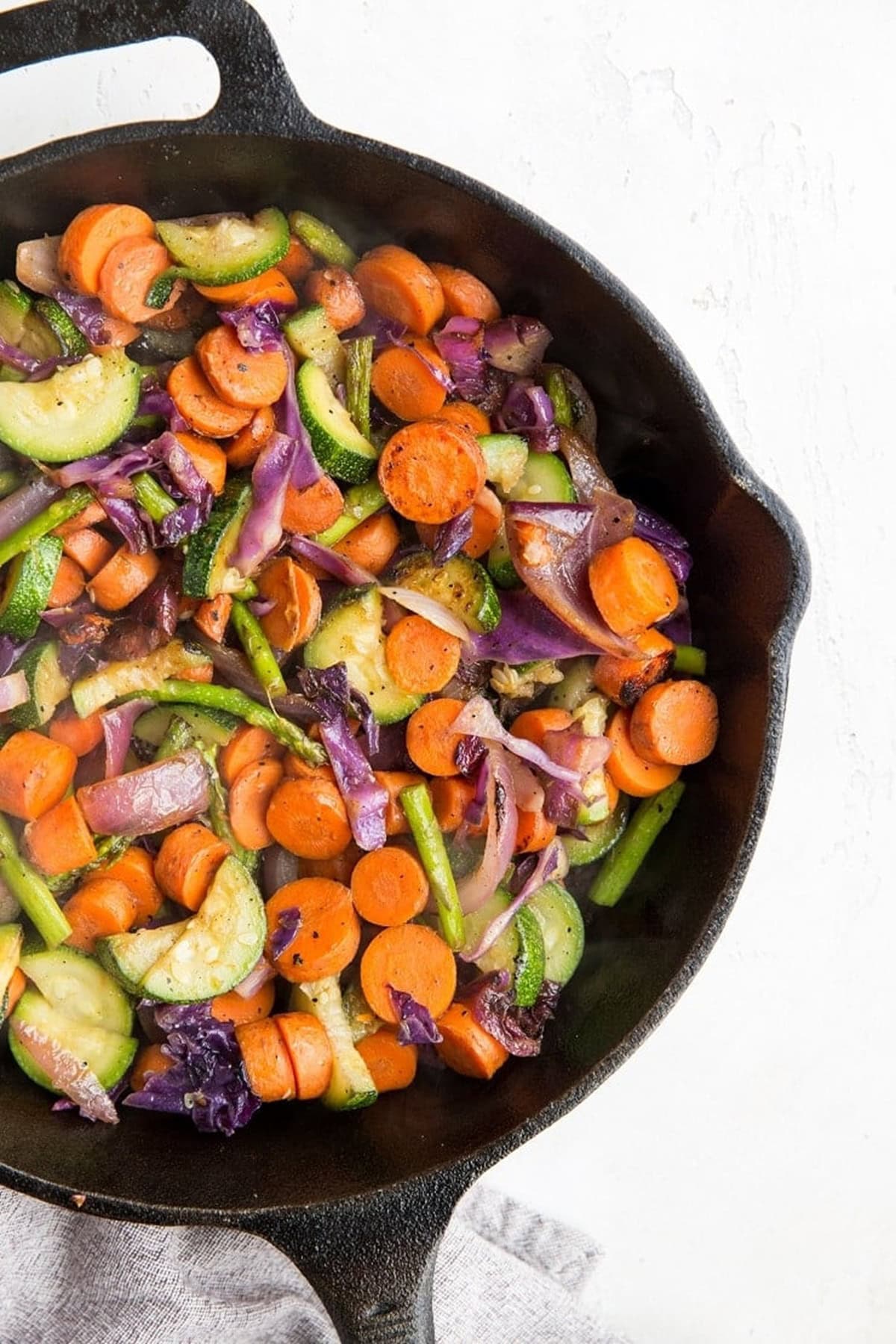
Tips for Perfect Sautéed Vegetables
- It’ll take some trial and error, but using just the right amount of oil is crucial here. Use enough to lightly coat the vegetables, but not so much that they’re dripping.
- Choosing when to season your vegetables affects how they cook! If you like them soft, add your salt before you cook. The salt draws out the moisture and lets your vegetables soften up quicker. If you prefer them crunchy and crispy, add salt at the end!
- A cast iron skillet is my ultimate sautéing weapon of choice. The combination of high heat and a cast iron pan guarantees you a perfect golden-brown crisp. It’s also a great way to boost your own iron intake! It’s best to use a metal spatula for a cast-iron pan, but stick to wooden or silicone for your standard steel or non-stick skillet to avoid scratching.
- If you can, find a lid to cover your pan with. It traps the heat and helps your vegetables cook evenly.
- Let the veggies sit for about 2 minutes in between stirring. Over-stirring vegetables can cause them to fall apart. A delicious sear we’re looking for.
- Toss the firmer vegetables (like carrots, potatoes, root vegetables etc.) into the pot first. After the hard veggies have softened, add the softer vegetables. This ensures all of the veggies turn out with the perfect level of doneness.
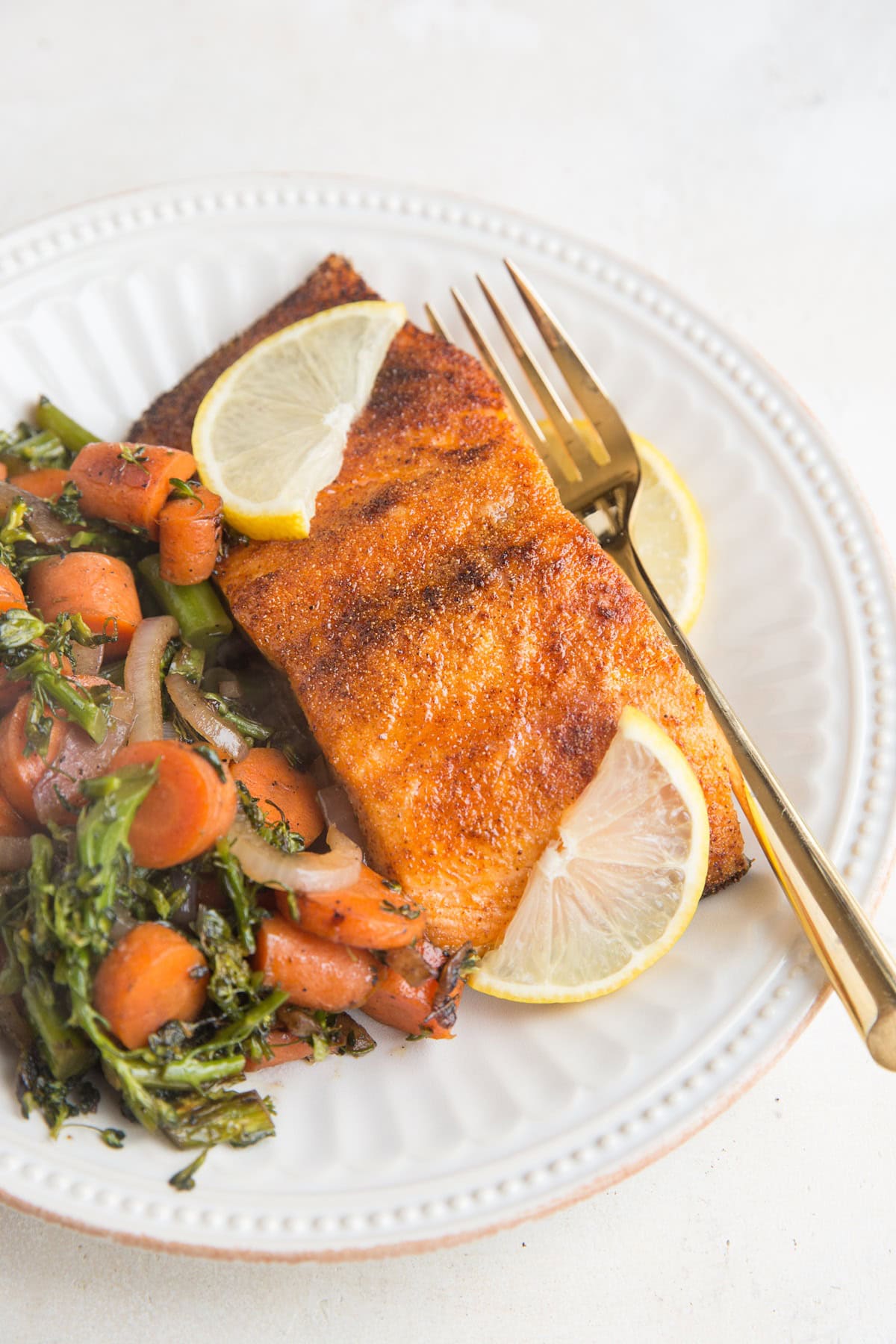
What Do They Taste Like?
It’s refreshingly simple and easy, but this easy sauté elevates your vegetables beyond belief.
I’m convinced that anyone who claims not to like vegetables just hasn’t cooked them properly. This method brings out the best in every veggie!
Mix and match your favorite flavors; there’s truly no wrong way to whip up a delicious, juicy, crunchy vegetable medley.
How to Sauté Vegetables:
Add the avocado oil to a large (10 to 12 inch) cast iron skillet and heat to medium-high heat.
Allow the skillet to warm up completely before adding the hearty vegetables (if you’re following this exact recipe, that’s the carrots and the onion).
Stir well until coated with oil, then cover the skillet and allow the harder vegetables to cook for a few minutes, until they begin to soften up.
Add the rest of the vegetables (zucchini, broccoli, cabbage, asparagus) and stir well. Season the vegetables with sea salt and cover the skillet.
Cook, stirring occasionally, until much liquid has seeped out of the vegetables and they have reached your desired level of done-ness, about 10 to 20 minutes total.
Remove the lid and allow some liquid to burn off before covering again if the veggies leach out a lot of liquid.
When using cast iron, use a metal spatula to get underneath the vegetables so that they don’t break apart and also preserve the golden-brown sear they’ll eventually get.
If at any point the vegetables become too dark or begin to burn, stir very well and lower the heat to medium for the remainder of the cooking process.
Serve with your favorite protein and enjoy!
Store leftovers in an airtight container in the refrigerator for up to 5 days.
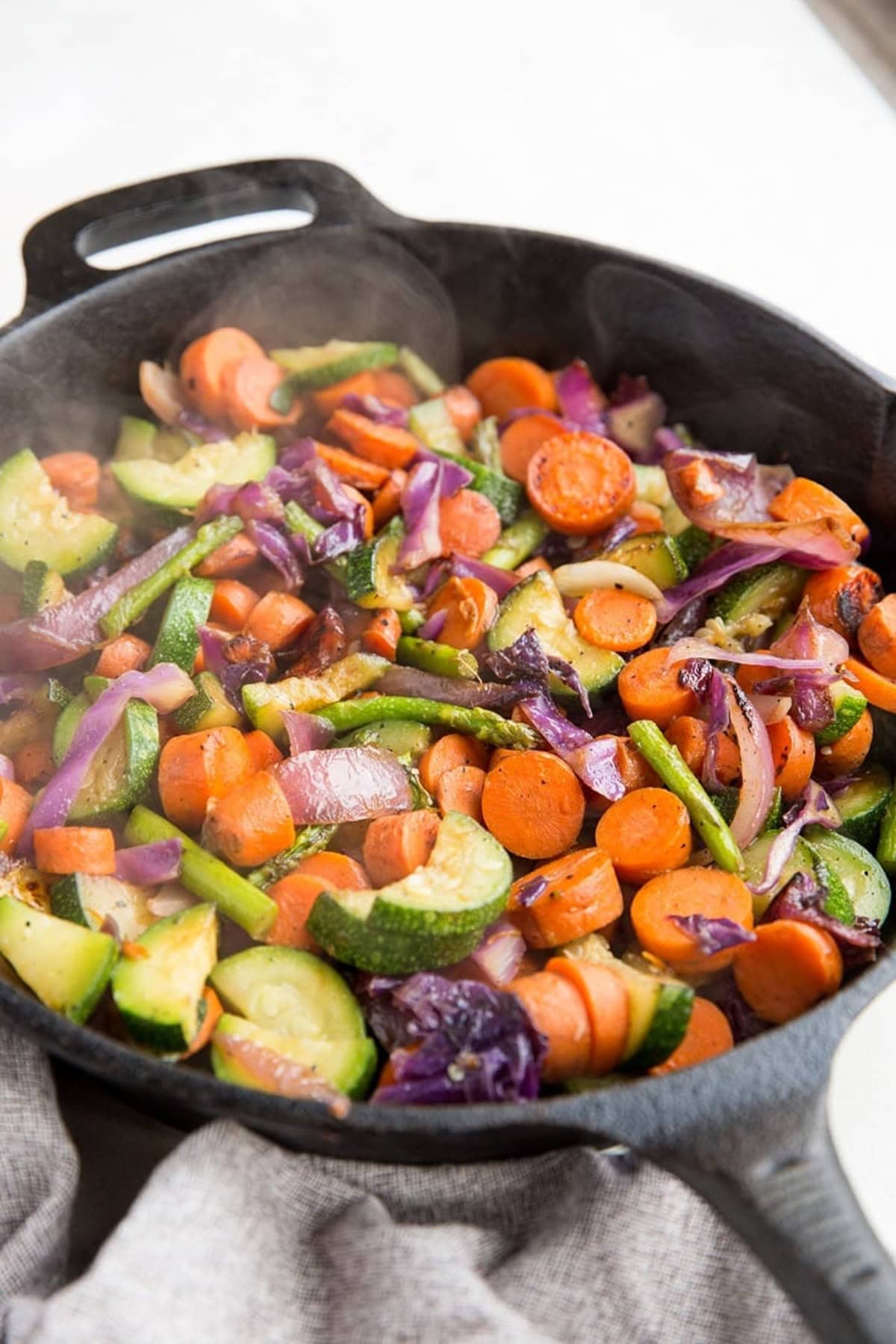
Super simple and remarkably tasty, this easy sautéing recipe is an absolute dream on busy weeknights. Perfect for meal prep, you’ll have many meals worth of veggies after cooking once.
Let me know which combinations of veggies you try! I hope you love this recipe as much as I do!
Enjoy these easy sautéed vegetables? Here are five more fantastic vegetable side dishes for you to try!
More Vegetable Side Dishes:
- Garlic Herb Roasted Vegetables
- Turmeric Roasted Cauliflower
- Perfect Roasted Carrots
- Air Fryer Asparagus
- Cheesy Vegan Roasted Cauliflower
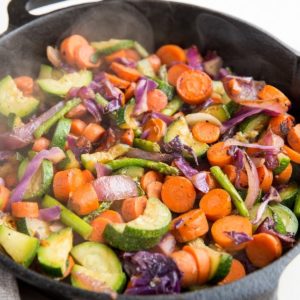
Easy Sautéed Vegetables Recipe
Ingredients
- 1 1/2 Tbsp avocado oil
- ½ small red onion sliced
- 4 large carrots chopped
- 2 medium-sized zucchini squash chopped
- 1 bunch broccolini chopped (or 1 large crown broccoli)
- ½ bunch asparagus trimmed and chopped
- 1 to 2 cups red cabbage thinly sliced
- ½ tsp sea salt to taste
Instructions
- Add the avocado oil to a large (10 to 12 inch) cast iron skillet and heat to medium-high. Allow the skillet to warm up completely before adding the hearty vegetables (if you’re following this exact recipe, that’s the carrots and the onion). Stir well until coated with oil, then cover the skillet and allow them to cook for a few minutes, until they begin to soften up.
- Add the less hearty vegetables (zucchini, broccoli, cabbage, asparagus) and stir well. Season the vegetables with sea salt and cover the skillet.
- Cook, stirring occasionally, until much liquid has seeped out of the vegetables and they have reached your desired level of done-ness, about 10 to 20 minutes total.
- If it appears at any point as though the vegetables are in a puddle of liquid, remove the lid and allow some liquid to burn off before covering again.
- If using cast iron, use a metal spatula to get underneath the vegetables so that they don’t break apart and also preserve the golden-brown sear they’ll eventually get.
- Allow the vegetables to sit for 2 minutes between stirring/flipping them to ensure they cook evenly.
- If at any point the vegetables become too dark or begin to burn, stir very well and lower the heat to medium for the remainder of the cooking process.
Nutrition
This post contains affiliate links, which means I make a small commission off items you purchase at no additional cost to you.

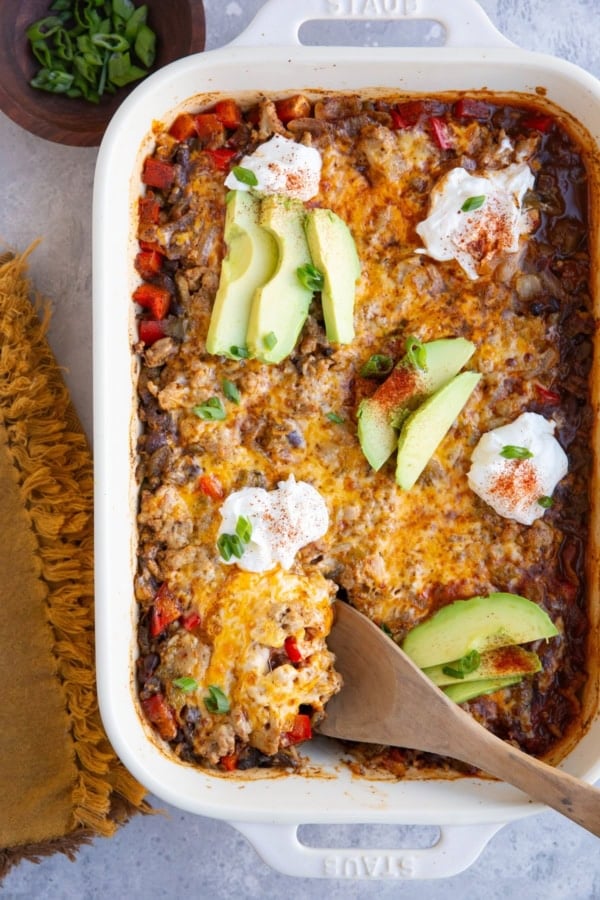
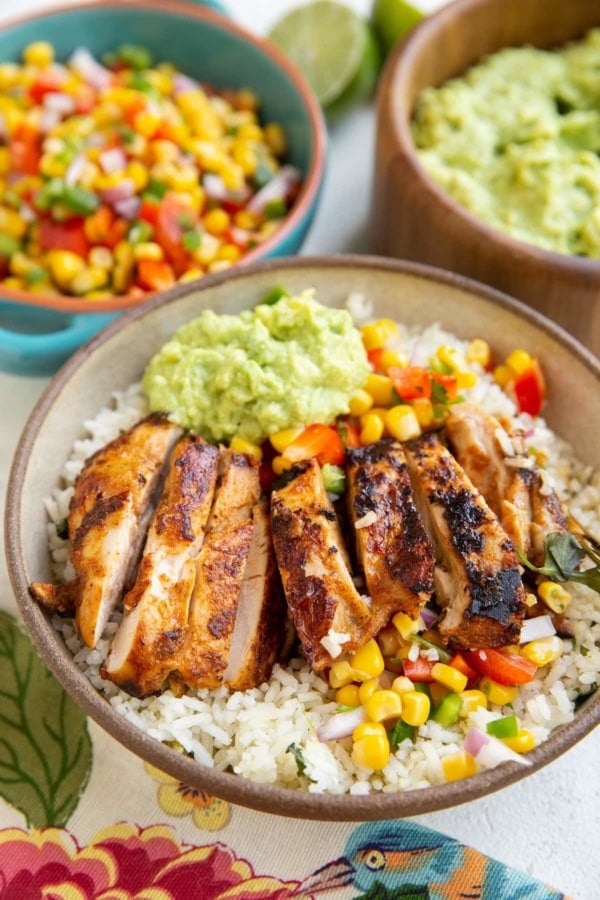
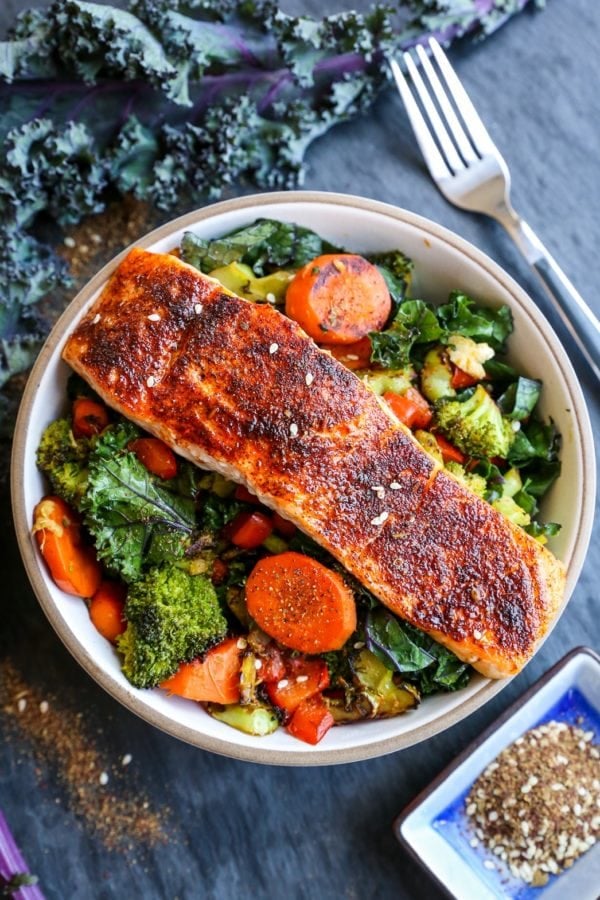
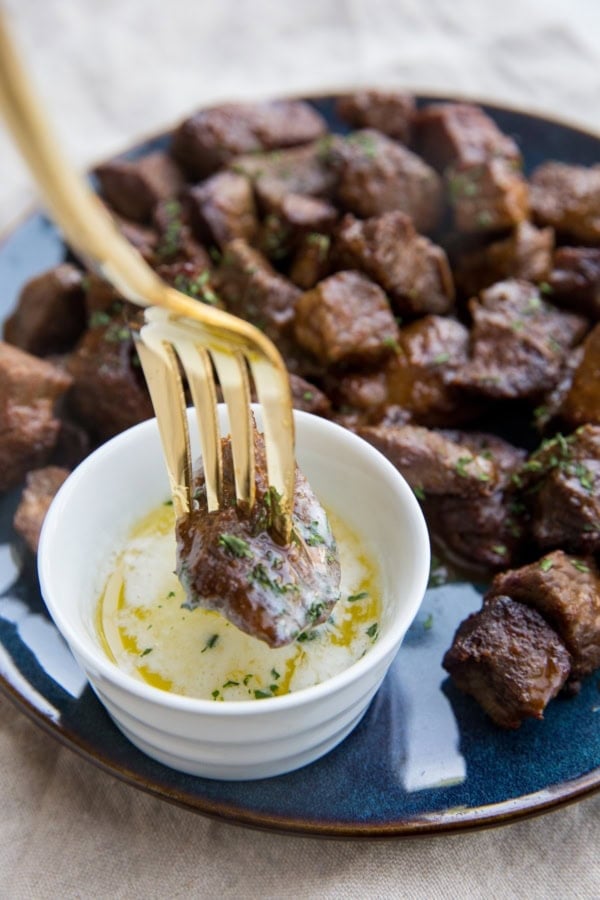









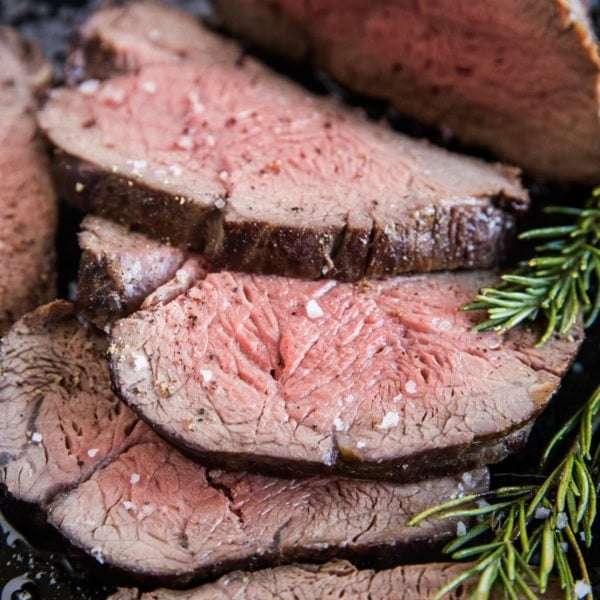
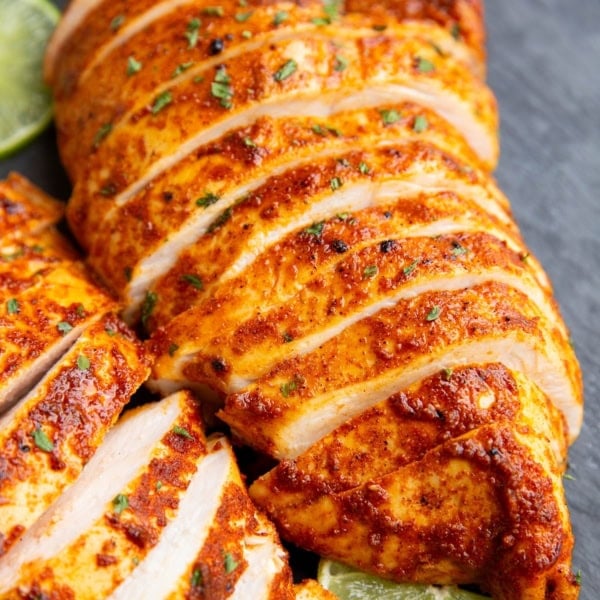
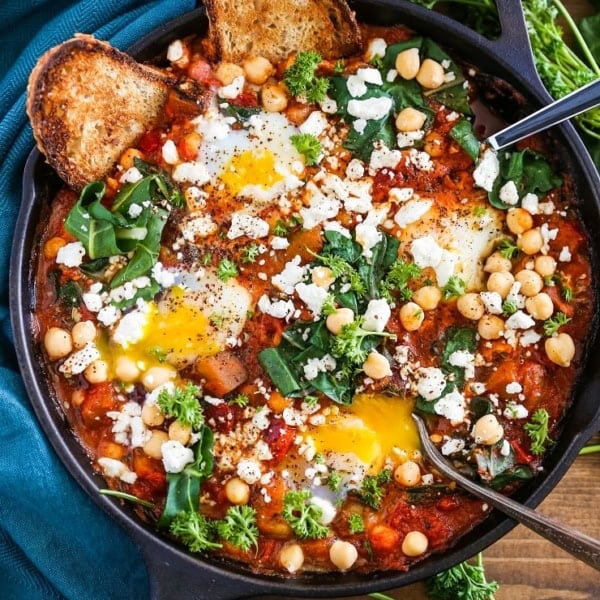
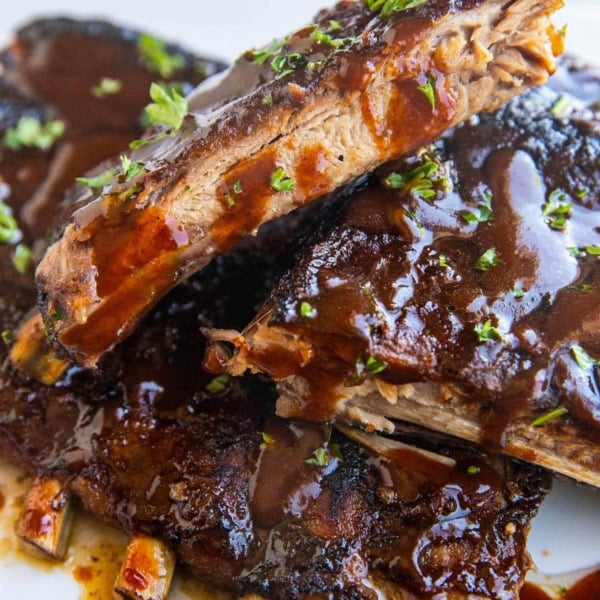
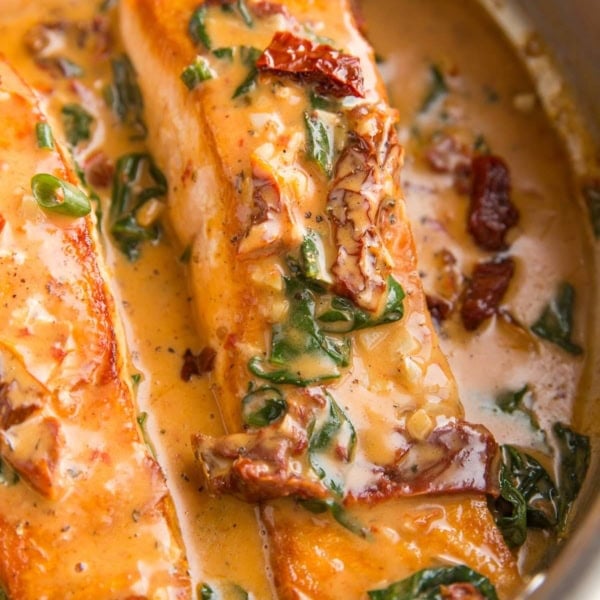
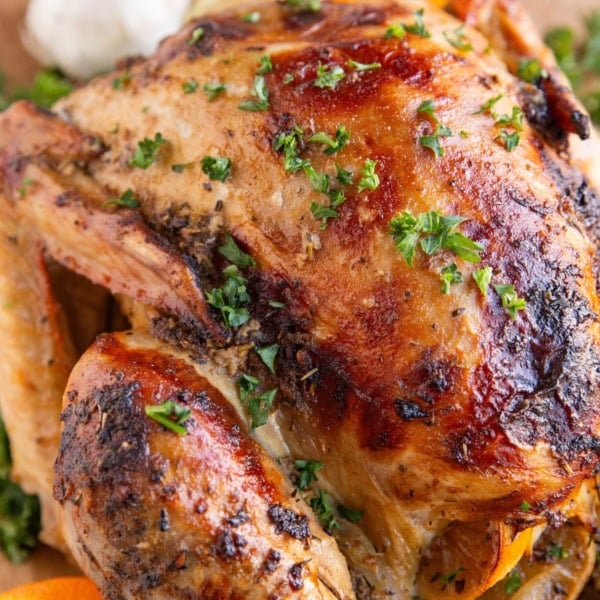
Is it just me or do other people find it absurd to assert that even a novice cook is unable to add vegetables to a dish according to how long they take to cook properly?
🧐
I’ve never even heard of only cooking vegetables together which are the same hardiness or cook times
🤷🏻
Sweet! Try sautéing sweet potato and zucchini together at the same time and let me know how it turns out.
wondering about how many cups of approximate cups of veggies before sautéed? Trying this with the Turkey Meatballs today!!
I’m so happy to hear that! For me, it typically ends up being around 6 cups of veggies. Hope you enjoy!